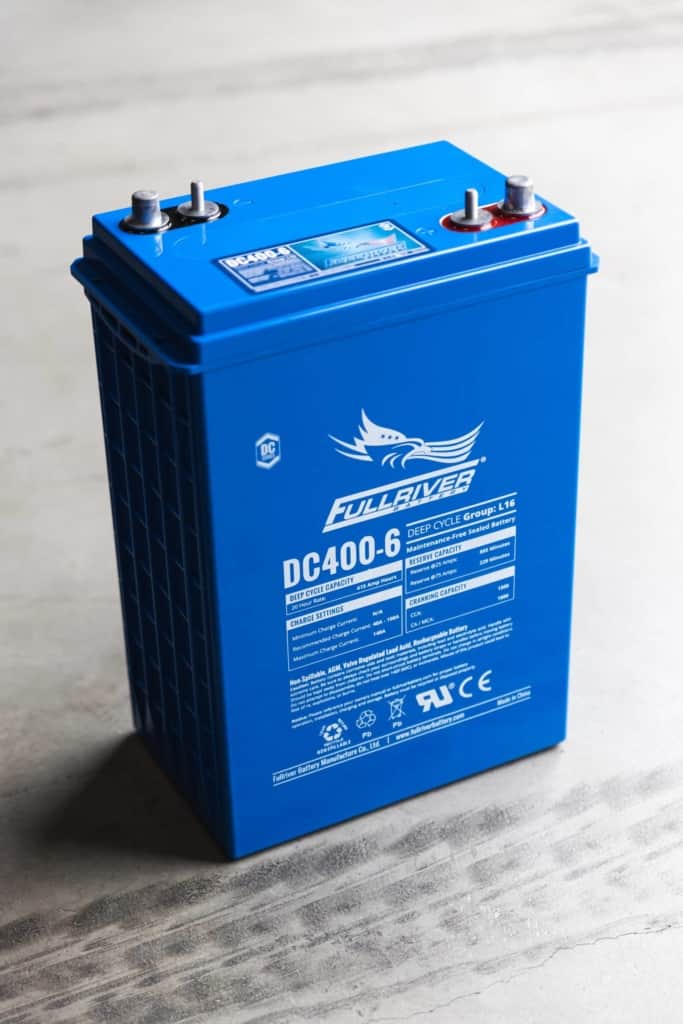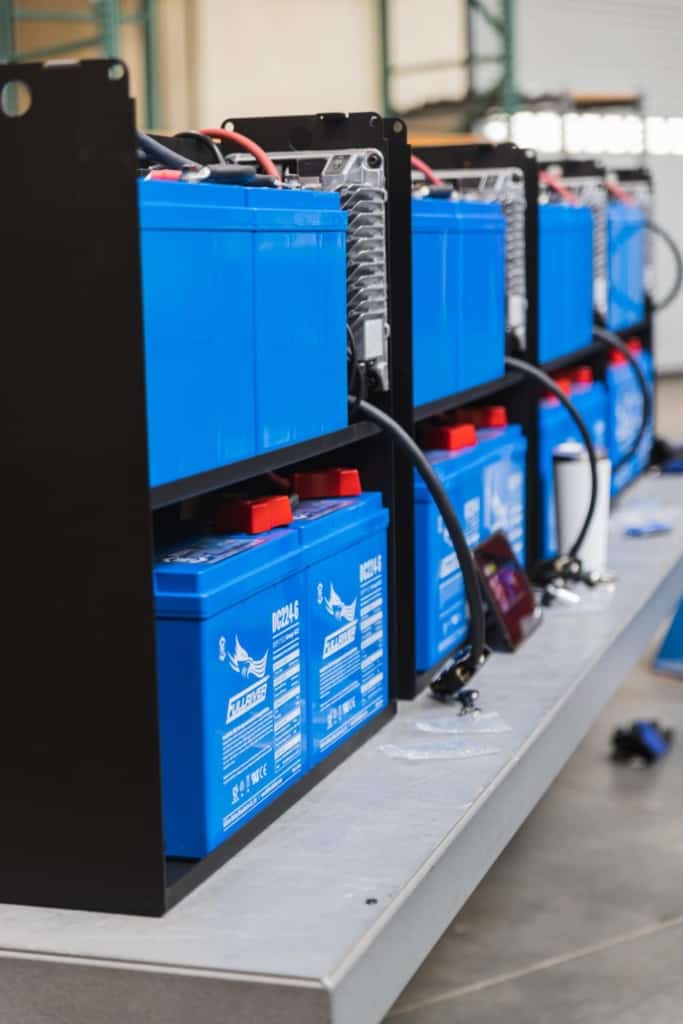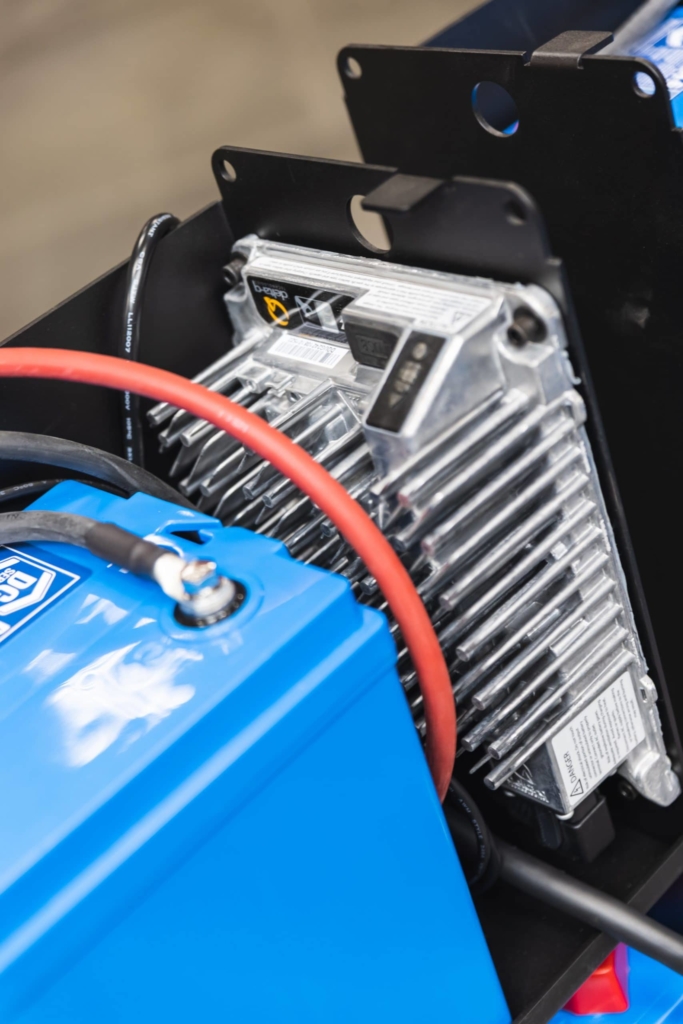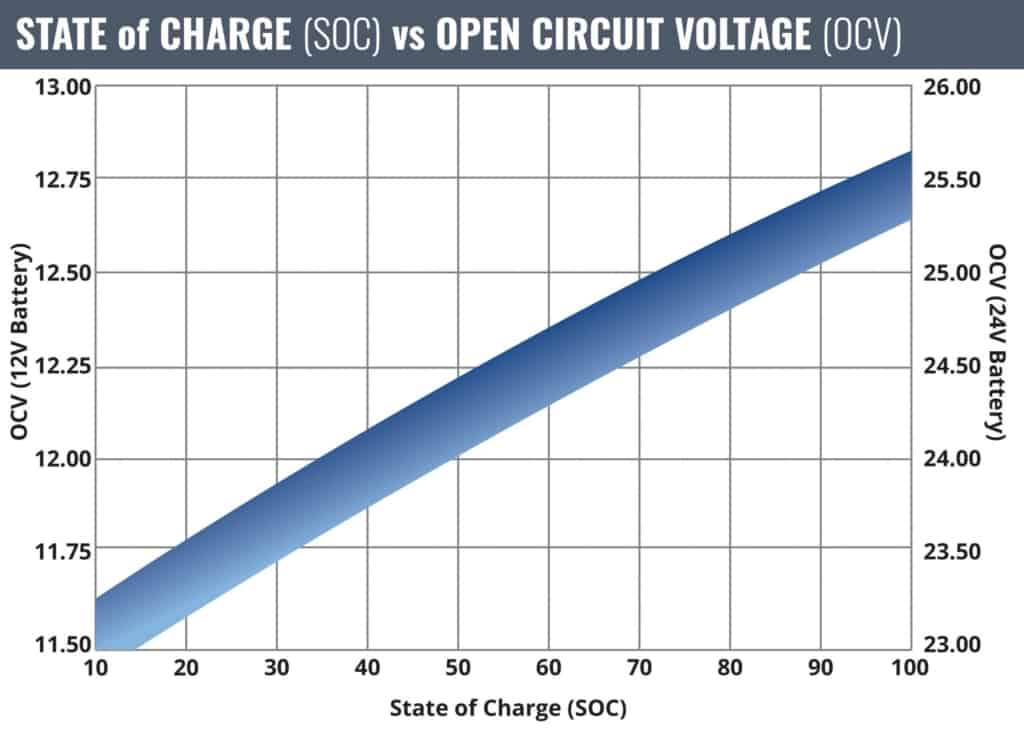How long does it take to charge an AGM battery? First, the good news, of all lead acid batteries available (Flooded, Gel, AGM), AGM charges faster and more efficiently than the others. However, there are a few important factors to consider before determining the answer to this question. Once these questions are answered, then we can estimate the time it will take to charge an AGM battery.
Size Matters?
The old saying “size matters” is very true when it comes to charging batteries. In AGM the physical size of the battery will typically indicate the amount of energy the battery can store. The more energy stored; the more energy that will need to be put back into the battery after it’s been used. For example, one of the smaller batteries from Fullriver is our DC35-12 (U1). At 420W/35Ah of stored capacity, the DC35-12 is approximately the size of two bricks stacked on top of each other. On the opposite end is our DC260-12 (8D), this beast holds 3,120W/260Ah, and is comparable in size to some laser jet printers.
The Red Cup
The next factor we must account for is the power output capability of the charger. Imagine it in terms of filling up a swimming pool with water and using a Solo Red Cup. But what if we were talking about a kiddie pool, nay a Barbie pool? Then the Red Cup might even be too big and harm the battery. Because we are returning energy to the battery, a 12V, 2A (24W) charge tender is going to take a lot longer to recharge a battery than a 12V, 25A (300W) charger, while at the same time using this 300W charger on the 420W DC35-12 is like filling the Barbie pool with a garden hose. Charging is all relative like our Red Cup analogy notes.



Goldilocks
And there’s one other thing to consider when choosing a charger, the Goldilocks principal. We don’t want to go too small (undercharge) or too big (overcharge), but we want it to be “just right”. Fullriver batteries can be charged with more amperage than a typical flooded or gel battery. We advise at a minimum 10% of rated capacity but recommend 25% in amp output from the charger (e.g., 100Ah battery should be charged with a minimum of 10A, but we recommend using a 25A charger to achieve 25%).
Are we there yet?
Finally, we can begin to answer the question that we started with using simple math. To determine how long it will take to charge an AGM battery, simply divide the rated capacity of the battery at the 20hr. rate by the amp output of the charger, and then multiply by 1.33 to account for the balancing phase of the charging and the natural aging of the battery.
Ah/A*1.33= ~Charge Time (H)
We’ll use our popular DC105-12, 12V, 105Ah battery, and assume it is discharged fully, recharging with a 25A charger:
100/25*1.33= ~5.58 or ~5hrs 30mins Of course, this accounts for a fully discharged battery, and gives a very good picture of how long recharging typically will take. In the real world you can perform this same exercise and get pretty close to the actual time by referencing the open circuit voltage (OCV) of the battery to our chart below:
In summary, we have seen that pairing the right sized charger and battery can make a great difference in charging a battery as quickly and efficiently as possible. Determining how much time recharging will take is just some simple math and a bit of estimation.
Did you already know this about recharging batteries? We’d love to hear some of your experiences with recharging batteries!



Is the charging from 90-100% as efficient as from 80-90%?
Should I avoid charging to 100% daily? Would I be better off cycling between 60-80% than 80-100%?
Sven,
Great questions.
80-100% is typically the absorb and finish phase of charging. This is the slowest portion of charging, where the charger is putting very low amperage in and the volts are ramping up to their maximum, this is also where cell balancing occurs. 90-100 is probably the least efficient, but should not be done away with.
Depending on DoD, you should fully recharge the battery to 100% at least once per week, if you aren’t dropping below 50% of capacity.
I have 120ah Fullriver AMG battery and use a 25Amp DC to DC in vehicle charger to recharge.
It takes many hours driving to charge the battery from 80% to 100%.
Can I reduce the absorption stage of charging by continuing the bulk stage up to 90% capacity?
Unfortunately, no. The internal resistance grows to such a level that the only way to continue feeding energy to the battery is to ease off of the amperage. This doesn’t have to happen every charge cycle, but at least once a week, if the battery is being used regularly.
I have a full river 120 agm in my canopy. Permantly connected is victron 75/15 mppt being fed by a 200w panel which sometimes struggles to keep up in winter or multiple overcast days. I also have a projecta 25a dcdc charger which i am putting in to keep battery topped up when the canopy is on the car. Can i use both at the same time? Maximum amps in prime conditions would be 40 amps although i rarely see more than 8 amps from solar. Just checking the battery will handle a potential 40 amp charge when it is run down.
Greg,
Excellent question. No, you should avoid using them together. Our max charge rate is 30%, but we recommend using only 25%. 40A is 33% of the battery’s rated capacity and exceeds the threshold of 30%.
Thank you for asking.
Hi there!
I am looking at the DC260 x2, for my 36ft boat.
Would a 100A charger work if it charged each one with 50A?
It is a smart charger called Enerdrive
How long does it take to charge from 50% DoD to 80% DoD on a new DC-120 battery using 30 amps? And how long to charge the same if the maximum recommended ie 35 Amps?
Hi, Rowan.
Yes, you can charge with as many as 65A per battery, and as little as 26A per battery. With 50A your right around 20% of rated capacity, which is good.
Best of luck out there.
This shows that AGM batteries are only suited for usages where there is lots of time to re-charge the battery. AGM is not suited to a yacht, because to run a generator or an alternator, would take too long to properly charge the battery. Use AGM if you are a week end sailor, but not for extended cruising. Carbon lead is an alternative to straight AGM though – the do not suffer as much from partial charging. But they still take a long time to charge. Lithium better suits a sail boat, they accept much greater charge, and they do not suffer if not fully charged. They are lighter to install as well, plus they take up more room. But alternators and generators need to be protected from over heating, and also from the battery’s halting charge instantly, which if directly connected to the alternator, can blow the alternator.
Thank you for your comment.
We recommend fully recharging at least once a week if possible. PSoC is only detrimental if it goes on for long periods. Even lithium needs a good balancing phase charge or it will fail long before it’s predicted life span.
Many of our Full-time sailors also employ solar and/or wind for keeping the batteries charged.
I have 12 fullriver DC224-6 AGM Batteries. 6 sets of those are in series so a bank of 6 12volt on a 50ft yacht. They are connected to a Victron multiplus 12/3000/120-50.. I have a12kw onan generator. I can’t find what My current threshold number should be. Right now it’s set at .10A. That along with what the setting for charging amps on the controller should be. Right now set at 45a. I hope you can help.
Steve,
Send an email to our tech support team, much more effective. Help@fullriverbattery.com
Also, you can view our complete manual here: https://resources.fullriverbattery.com/fullriver-battery/external-media/manuals/manual-batteries.pdf
Hello we just purchased a DC215-12 agm battery and our charge options on our Sterling Inverter/charger has two AGM options.
AGM 1 Boost 14.1 Float 13.4
AGM 2 Boost 14.6 Float 13.7
Which would be preferable?
Would it also be the same if we added more of the same type/model to the battery bank?
Thank you
Hi, Dave.
Use AGM 2 as that more closely matches our recommended voltages. This applies to any a larger or smaller bank size.
Regards,
Aaron
Hi I have a Fullriver DC120-12B Deep Cycle Group:31 battery in my camper trailer. I want to know if I should keep it charging (240v home power an Thunder battery charger, when at home and not in use. I have been told different answers. Can you please advise
Hi, Neil.
A lot is going depend on the length of storage and the ambient temps where the battery is stored.
Check out this article for a much more thorough treatment. If you have any questions, leave a comment over there and we’ll answer them for you.
https://fullriverbattery.com/articles/automotive/a-surprisingly-simple-winterizing-protocol/
Regards,
Aaron
None of this makes sense. Why not invent a simple system for all motorhomes and leisure battery set ups. All you need is…
1. A cable and adaptor which connects to allow the battery to charge while driving.
2. Box that conceals all the magic to make it work.
3. Clear reader that says what percentage (not voltage) the battery is at. – made by someone you’d recognise.
4. Plug in chargers for charging (only one size please that does it quickly and safely)
5. Converting kit for solar
Get rid of slow chargers, low power solar and make clear what it is for. Latest piece of advice is use a multimeter, Van Life is supposed to be freedom and living wild, not being a Professor in Physics and Electrical Engineering. Surely there is one answer to all this…but can anyone tell me a charger, a solar panel and most importantly a battery status reader that doesn’t require me to understand electricity.
So someone I know bought a 1995 volvo station wagon in signal red w/ very low miles that they were going to fix and sell but this person has fallen in love with said volvo wagon and has been neglecting his primary car that uses an AGM battery. so lets say your name is Jesus and we’re playing WWJD “what would Jesus do?” Alright here we go –>Jesus the following list comprises the condition and circumstances that have resulted in the current dilemma. Answer correctly and-you-could-win peace on earth in every dimension ARE-YOU-READY? (Yes) Jesus, what would you do? Ready, Go!
12v AGM battery (reads 0.99 volts using multimeter)
1000 cranking amps
900 cold cranking amps
160 reserve capacity minutes
reported 95Ah rating (not stated on battery itself)
Schumacher Battery Charger (SE-2352)
w/ 35 amp fast charge setting
or 2 amp slow charge setting
Hi
I have 2x 120ah agms on my boat. I never go below 12.2. I also have solar system.. I have just purchased a 30a AGM charger. I run my generator early mornings and the charger goes straight into bulk at 30a. I give it an hour then I let the mppt do the rest.
Is 30amps enough or should I get a 50a 2 stage charger from china?
Ray,
We recommend at least 10% of the battery’s Ah in amp output from the charge, and recommend 25% as ideal. In this case, with 240Ah, 30A is 12.5%, while 50A would almost 21%. The 50A charger will get through bulk more quickly, and do a better job at breaking up sulfation. So, our recommendation would definitely be to go for the higher output charger for bulk and let the solar do the rest of the charging.
Let us know if you have any questions.
Aaron
Hi,
I just installed 8 DC224-6 batteries wired in series parallel for a 12 volt bank. My charger is capable of 120 amps- a little on the lower side than recommened. The charger has user programmable settings for absorb and float voltages so I can set to your recommended values. I can also set a maximum absorb time up to eight hours. Do you have a recommended maximum absorb time?
Thank You
Hi, Chris.
Our installation manual has all of the info you need, include a formula for calculating your absorb time. See section 7.3.2
https://fullriverbattery.b-cdn.net/wp-content/uploads/battery-installation-manual-english.pdf
Let us know if we can help with anything else.
The insights on optimal charging rates and the ‘Goldilocks principle’ are invaluable. Understanding the balance between charger amperage and battery capacity ensures efficient charging and longevity. Highly recommend this guide for both beginners and seasoned users.
Hi Aaron,
120Ah FullRiver AGM, currently have a Redarc 20 BCDC – have just upgraded my alternator from40A to 80A (40 series Toyota Landcruiser)
Could I use a 3 stage Redarc 40ABCDC and not jeopardies the lifecycle of it. or is 25A a better option.
Josh, I would recommend sticking with the 25A version, the 40A is just a bit too much for one DC120-12.